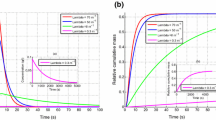Abstract
The accumulation of high explosive mass residue from the detonation of military munitions on training ranges is of environmental concern because of its potential to contaminate the soil, surface water, and groundwater. The US Department of Defense wants to quantify, understand, and remediate high explosive mass residue loadings that might be observed on active firing ranges. Previously, efforts using various sampling methods and techniques have resulted in limited success, due in part to the complicated dispersion pattern of the explosive particle residues upon detonation. In our efforts to simulate particle dispersal for high- and low-order explosions on hypothetical firing ranges, we use experimental particle data from detonations of munitions from a 155-mm howitzer, which are common military munitions. The mass loadings resulting from these simulations provide a previously unattained level of detail to quantify the explosive residue source-term for use in soil and water transport models. In addition, the resulting particle placements can be used to test, validate, and optimize particle sampling methods and statistical models as applied to firing ranges. Although the presented results are for a hypothetical 155-mm howitzer firing range, the method can be used for other munition types once the explosive particle characteristics are known.










Similar content being viewed by others
References
Crull, MM., (1998). “Prediction of primary fragmentation characteristics of cased munitions.” U.S. Army Engineering and Support Center, Huntsville, Alabama. Available at www.dtic.mil/cgi-bin/GetTRDoc?AD=ADA500203
Dortch, M. S., Johnson, B. E., & Gerald, J. A. (2013). Modeling fate and transport of munitions constituents on firing ranges. Soil and Sediment Contamination: An International Journal, 22(6), 667–688.
Hewitt, A. D., Jenkins, T. F., Ranney, T. A., Stark, J. A., Walsh, M. E., Taylor, S., Walsh, M. R., Lambert, D. J., Perron, N. M., Collins, N. H., Kern, R. (2003). Estimates for explosives residues from the detonation of army munitions. ERDC/CRREL Technical Report 03–16, Hanover, New Hampshire.
Hewitt, A. D., Jenkins, T. F., Walsh, M. E., Walsh, M. R., & Taylor, S. (2005). RDX and TNT residues from live-fire and blow-in-place detonations. Chemosphere, 61, 888–894.
Interstate Technology and Regulatory Council (ITRC). (2011). Incremental Sampling Methodology: Representative Sampling, Confident Decisions. http://www.itrcweb.org/ism-1.
Montanaro, P. E. (1990). TRAJ—A two dimensional trajectory program for personal computers. Washington: Naval Surface Warfare Center.
Papadopoulos, J. A. (2003). Munition metal parts manufacturing changes, 1920 to present, for unexploded ordnance database. Special publication ARWEC-SP-02001. Picatinny Arsenal: U.S. Army Armament Research, Development, and Engineering Center.
Pennington, J. C., Jenkins, T. F., Ampleman, G., Thiboutot, S., Brannon, J. M., Lewis, J., DeLaney, J. E., Clausen, J., Hewitt, A. D., Hollander, M. A., Hayes, C. A., Stark, J. A., Marois, A., Brochu, S., Dinh, H. Q., Lambert, D., Gagnon, A., Bouchard, M., Martel, R., Brousseau, P., Perron, N. M., Lefebvre, R., Davis, W., Ranney, T. A., Gauthier, C., Taylor, S., & Ballard, J. M. (2003). Distribution and fate of energetics on DoD test and training ranges: Interim report 3. ERDC TR-03-2. Vicksburg: U.S. Army Engineers Research and Development Center.
Pennington, J. C., Jenkins, T. F., Ampleman, G., Thiboutot, S., Brannon, J. M., Hewitt, A. D., Lewis, J., Brochu, S., Diaz, E., Walsh, M. R., Walsh, M. E., Taylor, S., Lynch, J. C., Clausen, J., Ranney, T. A., Ramsey, C. A., Hayes, C. A., Grant, C. L., Collins, C. M., Bigl, S. R., Yost, S., & Dontsova, K. (2006). Distribution and fate of energetics on DoD test and training ranges: Final report. ERDC TR-06-13. Vicksburg: U.S. Army Engineering Research and Development Center.
Taylor, S., Hewitt, A., Lever, J., Hayes, C., Perovich, L., Thorn, P., & Daghlian, C. (2004). TNT particle size distributions from detonated 155-mm howitzer rounds. Chemosphere, 55, 357–367.
U.S. Marine Corps. (1999). TTP for field artillery manual cannon battery. FM 6–40. Washington: Marine Corps Combat Development Command.
Walsh, M. R., Taylor, S., Walsh, M. E., Bigl, S. R., Bjella, K., Douglas, T. A., Gelvin, A. B., Lamber, D. J., Perron, N. M., & Saari, S. P. (2005). Residues from live fire detonations of 155-mm howitzer rounds. ERDC/CRREL Technical report TR-05-14. Hanover: U.S. Army Cold Regions Research and Engineering Laboratory.
Walsh, M. R., Walsh, M. E., Poulin, I., Taylor, S., & Douglas, T. A. (2011). Energetic tesidues from the detonation of common U.S. ordnance. International Journal of Energetic Materials and Chemical Propulsion, 10(2), 169–186.
Acknowledgments
We would like to acknowledge the funding support of the Environmental Security Technology Certification Program (ESTCP) and the guidance of Andrea Leeson, the Environmental Restoration program manager of ESTCP. Additionally, we thank the Cold Regions Research and Engineering Laboratory and Pacific Northwest National Laboratory for their resource support.
Author information
Authors and Affiliations
Corresponding author
Rights and permissions
About this article
Cite this article
Hathaway, J.E., Rishel, J.P., Walsh, M.E. et al. Explosive particle soil surface dispersion model for detonated military munitions. Environ Monit Assess 187, 415 (2015). https://doi.org/10.1007/s10661-015-4652-x
Received:
Accepted:
Published:
DOI: https://doi.org/10.1007/s10661-015-4652-x




